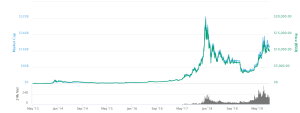Understanding and Utilizing the Bitcoin Fear and Greed Index
Master the Bitcoin Fear & Greed Index! Decode market sentiment, predict price swings, and make smarter crypto investments. Navigate the volatile world of Bitcoin with confidence.
The cryptocurrency market is notoriously volatile. Prices can swing wildly in short periods, leaving investors feeling uncertain. One tool designed to help navigate this volatility is the Bitcoin Fear and Greed Index. This index provides a quantifiable measure of market sentiment, offering insights into potential price movements. Understanding how to interpret and utilize this index can significantly enhance your investment strategies.
Understanding the Bitcoin Fear and Greed Index
The Bitcoin Fear and Greed Index is a metric that gauges the overall sentiment surrounding Bitcoin. It’s calculated using a combination of factors, including market momentum, volatility, social media activity, and surveys. A higher score indicates greed, suggesting a potentially overbought market, while a lower score signals fear, potentially indicating an oversold market. It’s crucial to remember that this index is not a perfect predictor, but rather a valuable indicator to consider alongside other market analyses.
Factors Influencing the Index
Several key factors contribute to the daily calculation of the Bitcoin Fear and Greed Index. These include:
- Volatility: High price swings often correlate with heightened fear or greed. Sharp increases signal potential greed, while significant drops can trigger fear.
- Market Momentum: Consistent upward trends might suggest investor greed, while prolonged downturns often fuel fear.
- Social Media Sentiment: The overall tone of discussions surrounding Bitcoin on platforms like Twitter and Reddit is analyzed to gauge public opinion.
- Surveys: Data from surveys asking investors about their current sentiment towards Bitcoin contributes to the overall score.
- Bitcoin Dominance: The percentage of the total cryptocurrency market capitalization held by Bitcoin can also play a role. A rise in dominance might suggest increased investor confidence.
The weighting of each factor in the calculation is often proprietary, meaning the exact formula isn’t publicly disclosed. However, understanding the general factors involved allows for a more nuanced interpretation of the index.
Interpreting the Index Scores
The Bitcoin Fear and Greed Index typically ranges from 0 to 100. Scores below 25 generally indicate extreme fear, suggesting a potentially oversold market. Scores between 25 and 49 represent fear, while scores between 50 and 75 show greed, and scores above 75 indicate extreme greed, potentially signaling an overbought market. These are broad ranges, and the interpretation should be contextualized with other market indicators.
Extreme Fear (0-25):
An index score in this range historically indicates a market downturn. Investors are generally pessimistic, leading to potential buying opportunities for those with a long-term perspective. However, it’s important to note that the market can remain in this state for extended periods.
Fear (25-49):
This range suggests a cautious market sentiment. While not as dire as extreme fear, investors remain hesitant. This phase might offer moderate buying opportunities for those with a risk tolerance.
Neutral (50):
A score of 50 represents a relatively neutral market sentiment. Investors are neither overly optimistic nor pessimistic. This doesn’t necessarily indicate a buy or sell signal, but rather a period of market consolidation.
Greed (50-75):
In this range, investors exhibit increasing optimism. This suggests a potentially overbought market, implying that prices may be inflated and susceptible to a correction. Caution is advised in this zone.
Extreme Greed (75-100):
Scores in this range indicate extreme optimism and potentially an overbought market. This is often a period where investors are highly enthusiastic, leading to the possibility of a significant price correction. Taking profits or adopting a more cautious approach might be prudent.
Using the Index in Your Investment Strategy
The Bitcoin Fear and Greed Index shouldn’t be the sole determinant of your investment decisions. It’s a valuable tool, but it should be used in conjunction with other forms of technical and fundamental analysis. Combining the index with price charts, trading volume, and news events can provide a more holistic understanding of the market.
Combining with Technical Analysis:
Technical analysis focuses on price charts and indicators to identify trends and potential price movements. Using the Fear and Greed Index alongside technical indicators like moving averages or relative strength index (RSI) can help confirm potential buy or sell signals. For example, a high Greed score coupled with an overbought RSI might suggest a potential sell opportunity.
Combining with Fundamental Analysis:
Fundamental analysis focuses on the underlying value of Bitcoin and the broader cryptocurrency market. This involves assessing factors like adoption rates, regulatory changes, and technological advancements. A high Greed score, despite positive fundamental developments, might still signal an overbought market. Conversely, a low Fear score might not be an automatic buy signal if fundamental factors suggest underlying weaknesses.
Risk Management:
Regardless of the Fear and Greed Index score, always practice sound risk management. Never invest more than you can afford to lose. Diversification is crucial; don’t put all your eggs in one basket. Regularly review your portfolio and adjust your strategy as needed.
Limitations of the Bitcoin Fear and Greed Index
While the Bitcoin Fear and Greed Index is a helpful tool, it’s essential to acknowledge its limitations. It’s not a perfect predictor of future price movements. The index is based on a range of factors, some of which are subjective and may not always accurately reflect the true market sentiment. Furthermore, market behavior can be unpredictable, and unexpected events can significantly influence prices, regardless of the index’s reading.
The index is also reactive rather than predictive. It reflects past market sentiment and doesn’t foresee future events. Therefore, relying solely on the index for investment decisions can be risky. It’s crucial to incorporate a broader range of analytical tools and strategies.
Other Market Indicators to Consider
It’s crucial to consider other market indicators alongside the Bitcoin Fear and Greed Index. These could include:
- Trading Volume: High trading volume can indicate strong interest in the market, while low volume might suggest a lack of conviction.
- Moving Averages: These provide an average price over a specified period, helping identify trends and potential support/resistance levels.
- Relative Strength Index (RSI): This momentum indicator helps identify overbought and oversold conditions.
- On-Chain Metrics: These metrics analyze data from the Bitcoin blockchain itself, providing insights into network activity and adoption.
By combining the Bitcoin Fear and Greed Index with these additional indicators and conducting thorough research, investors can develop a more comprehensive understanding of the market and make more informed decisions.
Ultimately, the Bitcoin Fear and Greed Index serves as a valuable tool for gauging market sentiment, but it shouldn’t be the sole factor influencing your investment choices. It’s a part of a larger puzzle, and utilizing it effectively requires careful consideration of other market factors and a well-defined investment strategy. Consistent monitoring, research, and diversification are key to navigating the volatile world of cryptocurrency investing.
Remember, understanding market dynamics and implementing sensible risk management strategies are paramount to success in this space. Always stay informed and adaptable to changing market conditions. Thorough due diligence is essential before making any investment decisions, and seeking professional financial advice is often recommended.
Investing in cryptocurrency carries significant risk. Prices can fluctuate dramatically, and there’s always the possibility of losing your investment. It’s crucial to be aware of these risks before engaging in cryptocurrency trading.
The Bitcoin Fear and Greed Index is a helpful tool, but responsible investment practices are paramount. Never base your entire strategy solely on one indicator.
Ultimately, responsible and informed investment is the key to navigating the complexities of the cryptocurrency market.







